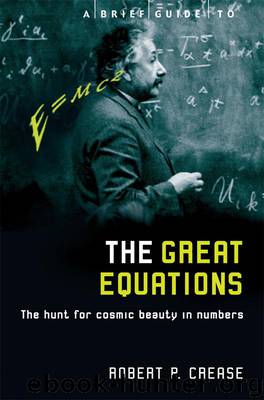A Brief Guide to the Great Equations by Robert Crease

Author:Robert Crease
Language: eng
Format: mobi, epub
Tags: Science, General
ISBN: 9781472100177
Publisher: Robinson
Published: 2012-05-17T00:00:00+00:00
Here the famous equation – energy is equal to the mass times the speed of light squared – appears with the corrective factor ß, which takes into account the effect when the body is in motion. That is, let’s take a piece of matter such as an electron. At rest, every electron has the same mass; it’s as if nature stamped that mass on each electron when it was created. Whenever that electron is weighed in its own reference frame, it always has that mass. Now suppose we look at it from another reference frame, in which the electron is moving. If E = mc2, and c is a constant, then m and e have to vary in exactly the same way as the energy increases. The electron’s inertial mass – its mass from its own rest frame – does not change. But its mass as you measure it in the laboratory, where you see it as moving, changes. And ß, the compensation factor, is the transformation that tells you what to multiply by to get the rest mass. Leaving out that compensating factor gives you what he calls in a footnote the ‘simplifying stipulation μV2 = ε0.’22
Later that year, Einstein changed his symbols to use c rather than V for the speed of light. The theory of relativity contains a result of ‘extraordinary theoretical importance’, he says; that ‘the inertial mass and the energy of a physical system appear in it as things of the same kind. With respect to inertia, a mass μ is equivalent to an energy content of magnitude μc2.’23 Over the next few years, Einstein worked out more fully the mass-energy principle and its implications. And in a manuscript on relativity theory of 1912, at the beginning of a discussion of the subject, he writes the above formula using m in place of μ, and a script L (as in the first version) in place of ε then crosses it out and writes E. From then on, he sticks with E and c, and we now have the familiar equation plus the corrective factor where q (sometimes written as v) stands for the velocity:24
Download
A Brief Guide to the Great Equations by Robert Crease.epub
This site does not store any files on its server. We only index and link to content provided by other sites. Please contact the content providers to delete copyright contents if any and email us, we'll remove relevant links or contents immediately.
Enlightenment Now: The Case for Reason, Science, Humanism, and Progress by Steven Pinker(7228)
A Journey Through Charms and Defence Against the Dark Arts (Harry Potter: A Journey Through…) by Pottermore Publishing(4781)
The Immortal Life of Henrietta Lacks by Rebecca Skloot(4525)
A Journey Through Divination and Astronomy by Publishing Pottermore(4344)
Elon Musk by Ashlee Vance(4027)
Origin Story: A Big History of Everything by David Christian(3648)
COSMOS by Carl Sagan(3554)
Alchemy and Alchemists by C. J. S. Thompson(3448)
Bad Pharma by Ben Goldacre(3355)
Enlightenment Now by Steven Pinker(3335)
Shadow of Night by Deborah Harkness(3298)
Inferior by Angela Saini(3276)
A Mind For Numbers: How to Excel at Math and Science (Even If You Flunked Algebra) by Barbara Oakley(3217)
Origin Story by David Christian(3147)
The Code Book by Simon Singh(3074)
Signature in the Cell: DNA and the Evidence for Intelligent Design by Stephen C. Meyer(3071)
The Elements by Theodore Gray(2997)
A Brief History of Time by Stephen Hawking(2960)
A Journey Through Potions and Herbology (A Journey Through…) by Pottermore Publishing(2826)
